Good-Better-Best: Comprehensive Best Practices for Implementing Public Transportation Security Systems (Vol. 1)

Public transportation systems provide large volumes of people with reliable access to affordable passage. They are designed to reduce friction, allowing passengers to enter and exit the systems seamlessly and on demand. This volume of people and ease of access, combined with the confined spaces and location of these systems in massive city centers, makes public transportation susceptible to adversarial targeting and threats. Terrorism is indeed the worst-case scenario, but in systems like these, the day-to-day security and safety concerns, such as crime or accidents, are the ones that keep security teams busy. With so many vehicles and passengers in motion on a given day, accidents and incidents occur numerous times per day, and coordination with law enforcement is key when an emergency arises.
In this guide for security practitioners – the second in a series of Good-Better-Best (G-B-B) use cases – the Security Industry Association (SIA) provides comprehensive best practices for implementing security systems in public transportation environments, specifically a multi-modal urban transportation hub.
- What Is G-B-B?
- G-B-B for Transportation Security
- G-B-B System Design Methods
- Transportation High-Priority Systems
- Design Leveraging IoT Trends
- Using the G-B-B Project Detail
- Transportation Facility Safety Systems
- G-B-B Project Value Detail
WHAT IS G-B-B?
Whether you are a facility manager, risk management professional or safety officer or have more of a “traditional” title of security program manager, points of reference are an absolute must when investing capital in electronic security and safety solutions. The question remains, “what is the reference criteria needed to make an informed decision on the most appropriate fit when it comes to security products and services for my facility?”
The fact that you’ve taken the time to research how to make an informed decision is a significant leap in the right direction away from “lowest qualified price” criteria. Now, this doesn’t mean understanding pricing strategy is any less important to measuring the improvement to a “better” or “best” level from a minimum needs level that we’ll refer to as “good” in this document.
Regardless of what offering is made and what criteria were used in developing that design, all choices need to reflect how the security dealer or systems integrator works together with the end user as a trusted advisor or business partner.
Good:
-
-
- The offering meets minimum compliance requirements
- Security supports deterrence detection and response for most common threats
- Most systems are standalone
-
Better:
-
-
- The offering includes a wider range of and/or more accurate sensors
- Product selection is customized to match a specific operation
- The offering includes basic systems integration
-
Best:
-
-
- There is a measurable return on investment through technology enhancements
- The offering includes advanced systems integration – all systems can share data sets, enabling system-wide analytics
-
G-B-B for Transportation Security
Public transportation systems provide large volumes of people with reliable access to affordable passage. They are designed to reduce friction, allowing passengers to enter and exit the systems seamlessly and on demand. This volume of people and ease of access, combined with the confined spaces and location of these systems in massive city centers, makes public transportation susceptible to adversarial targeting and threats. Terrorism is indeed the worst-case scenario, but in systems like these, the day-to-day security and safety concerns, such as crime or accidents, are the ones that keep security teams busy. With so many vehicles and passengers in motion on a given day, accidents and incidents occur numerous times per day, and coordination with law enforcement is key when an emergency arises.
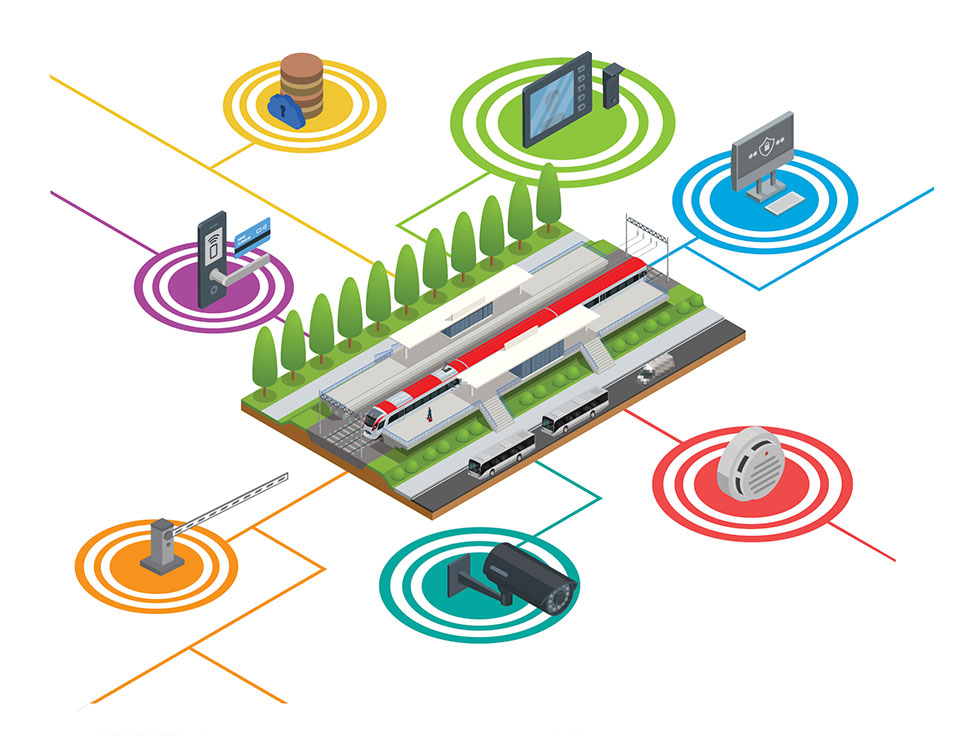
For the second in a series of G-B-B use cases, SIA focused on public transportation, specifically a multi-modal urban transportation hub. SIA collaborated with industry professionals to outline Good-Better-Best security cases. SIA’s Public Safety Interest Group, which brings together various stakeholders in the public safety ecosystem – including practitioners, integrators and manufacturers – then reviewed the guidance. Transportation is a broad topic, and future volumes of this Good-Better-Best transportation series will focus on other public transportation modalities.
According to guidance issued by the Federal Transit Administration, public transportation agencies should be moving from governance focused on compliance to a more proactive data driven program based on the principles of safety management systems (SMS), which help organizations improve upon their safety performance by supporting the institutionalization of beliefs, practices and procedures for identifying, mitigating and monitoring safety risks. SMS activities proactively detect safety concerns and organizational factors and correct them using data-driven prioritization. As such, important to SMS success are the:
- Effective collection, analysis and sharing of safety data
- Active, accurate and routine safety performance measurement
The Good-Better-Best approach matches this approach; as a system moves from good to best, the amount of data distribution and collection between systems increases. For example, sharing of data from security and safety systems with other transportation operational teams can help identify risks such as litter on the tracks, which can lead to fires, corroded or otherwise damaged rails or a person falling onto the tracks.
The guidance in this G-B-B document considers security features to help mitigate the risk or aid in the response or resolution of incidents such as, but not limited to:
-
-
- Accidents, including collisions, crash damages to vehicle occupants or bystanders (e.g., pedestrians, cyclists, occupants of other vehicles) and falls
- Crimes, including terrorist attacks, vandalism, sabotage, unauthorized access (e.g., unpaid access to systems or non-passenger areas), theft and trespassing
- Other incidents, including suicides and suicide attempts, coordination with law enforcement on crimes outside the system and egress monitoring
-
G-B-B System Design Methods
There are numerous types of devices used in each of the typical electronic security system (ESS) categories used in G-B-B; the types of security and safety systems are listed in this graphic.
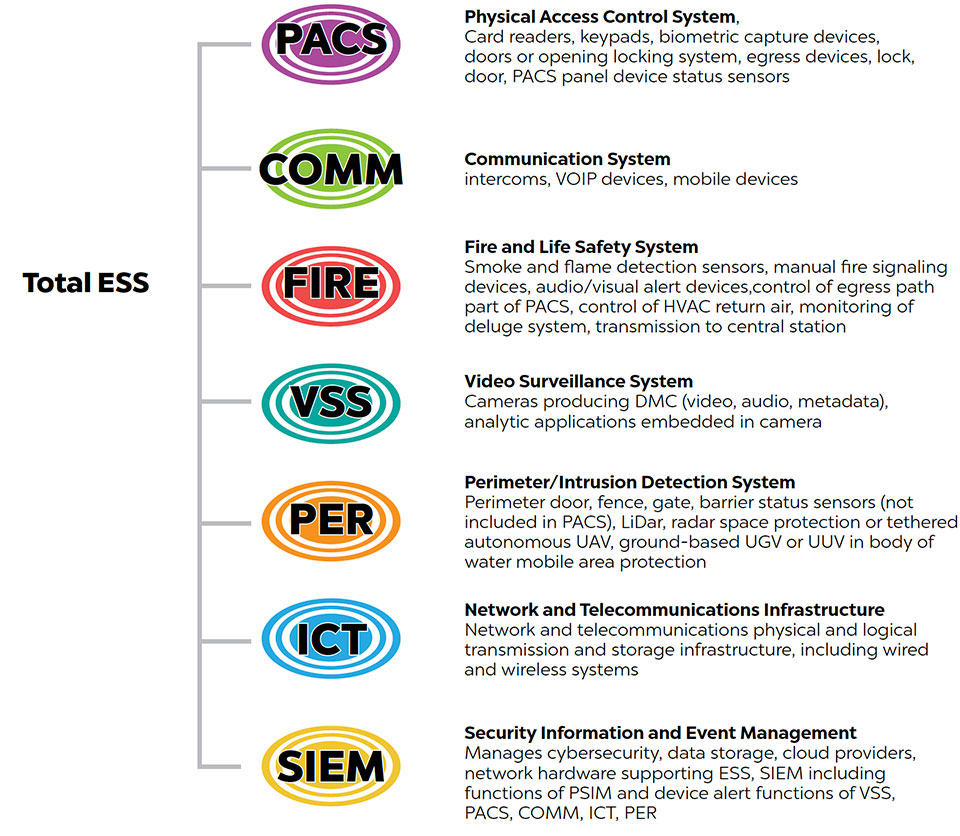
The types of security and safety systems: Physical access control systems (PACS), communication systems, fire and life safety systems, video surveillance systems, perimeter/intrusion detection systems, network and telecommunications infrastructure and security information and event management (SIEM). To view the guidance with all graphs and charts, please download the full PDF.
Transportation High-Priority Systems
Given that fire, voice evacuation, signaling, life safety systems, power distribution, backup power for critical systems and fare collection equipment are the highest priority in any type of transportation hub setting and require specialized installation, we are not covering those within the scope of this document’s guidelines and best practices.
Design Leveraging IoT Trends
According to Forbes, there were 8.4 billion connected devices in 2017, expected to more than double by 2020. This prediction proved to be greatly underestimated, as the smart device trends for 2019 report the number of Internet of Things (IoT) devices expected to quintuple to 125 billion by 2030. The trend of “everything connected” has led to wide-ranging estimates on the current state to the increase in network-connected devices. Many of these are in both the industrial security and consumer electronics industries, and the effect of consolidating platforms to support this growth leads us to a design approach in G-B-B.
The four biggest issues facing IoT technology and the evolution of many classes electronic security devices are:
-
- Power management
- Connectivity
- Hardware performance and compatibility
- Platform integration, especially with cybersecurity, policies and upgrades
With these requirements comes a focus on specifying the best sensor/device for a given location and providing cross-system compatibility and integration by sharing a common platform wherever possible. As stated in the graphic about ICT, when network infrastructure is equipped with IEEE 802.3af and IEEE 802.3bt Power over Ethernet ports to power the security devices and panels, reliability is significantly improved as the power sources are monitored, managed and backed up.
Using the G-B-B Project Detail
The detailed spreadsheet of ESS equipment and function is organized the same way one would perform a site survey: by location, as shown in this figure.
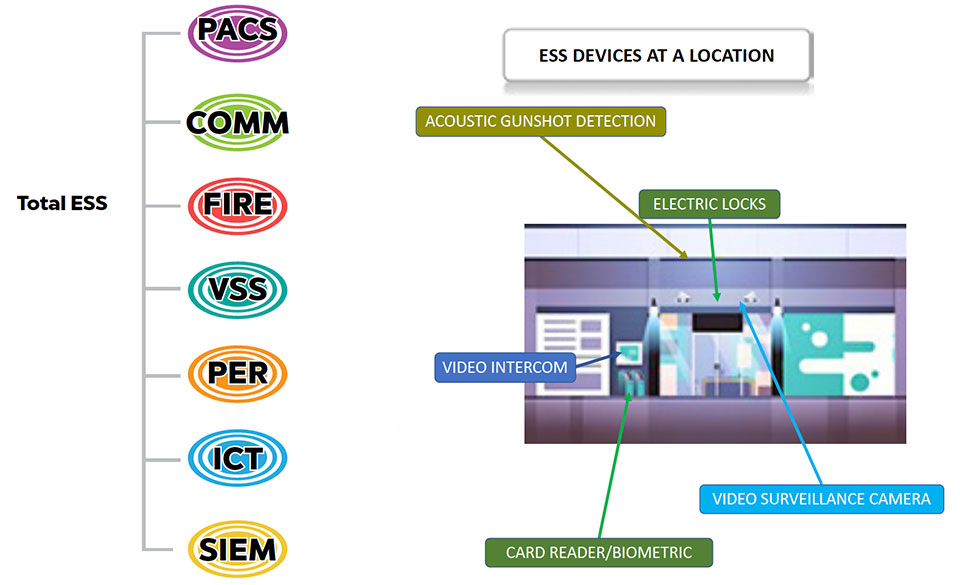
Demonstration of how ESS and equipment and function are organized by location, including acoustic gunshot detection, electric locks, video intercom, card readers/biometrics and video surveillance cameras. To view the guidance with all graphs and charts, please download the full PDF.
This method puts the sensors and devices that provide situational awareness as a high priority and allows the designer to select a consolidated platform to reduce software licensing costs and reduce operator training time. What if there is no single platform to support all these devices? This is the best point in the project design to discover which ESS system is already budgeted in the SEIM and ICT platforms through joint efforts with an enterprise IT department. If system support is unavailable for a given specialized security device or integration would be at an unreasonable expense, that device should be included in the project as a recommendation and included on the security integration and IT road map.
There are many other approaches to designing the total ESS, including the following:
- Build out each system by G-B-B tier, then perform value engineering to avoid duplication or over-complication.
- Specify integrated software platform first, then separate ESS individual systems that do not fully integrate.
Overall, there are two main types of risks in the design approaches. There is risk of specifying devices separately and, by extension, multiple platforms to manage security data that could be processed more effectively in a single virtual or cloud environment capable of scaling on demand. Additionally, there is the risk of specifying the platforms first and missing out on “best of class” sensors that are better suited to an environment.
Transportation Facility Safety Systems
Mass Notification Systems
The latest notification systems include network-wide alert mechanisms that provide real-time, system-wide information and updates on emergency conditions. These systems include signage for on-premises customers or may be linked to mobile applications.
Transportation Facility Security
Security and life safety measures are essential in any transportation facility. Sensors, both physical and IoT/video technology-based, offer notifications to operations and security personnel to deploy response. Emergency beacons, strategically placed in these locations, provide additional points for communications for faster response times.
G-B-B Project Value Detail
In the G-B-B project value detail (spreadsheet), location symbols used are as follows:
- Numbered symbols indicate physical locations: ⓪① ② ③ ④ ⑤ ⑥ ⑦ ⑧ ⑨ ⑩ ⑪ ⑫ ⑬ ⑭ ⑮ ⑯⑰ ⑱ ⑲ ⑳
The following are the G-B-B equipment details for each location, with a summary differentiating good, better and best versions.
① Main Station Entrance
Main thoroughfare which may include turnstiles, automated fare vending kiosks, station managers booth, managers booth, and entrance to retail/convenience kiosks. Leads to access to all platforms and waiting areas.
- Outdoor cameras’ quantity and placement are 60 pixels per foot (ppf) (Good), 80ppf (Better), 120ppf (Best) allowing facial recognition (FR) as Best, for public safety personnel within a security operations center
- Audio and video intercoms always voice over Internet Protocol (VoIP) compatible; video intercom is video over IP compatible (desktop VoIP station) and mobile computing device compatible
- Door status contacts are built into locking systems or sliding door systems for Better and Best
- The physical access control system (PACS) has lockdown and full door release controls (Better, Best
- PACS lockdown and full door release controls (Best)
- All virtual security system (VSS) camera and PACS panel power provided by network switches with PoE (Better); lock power provided by PoE++ (Best)
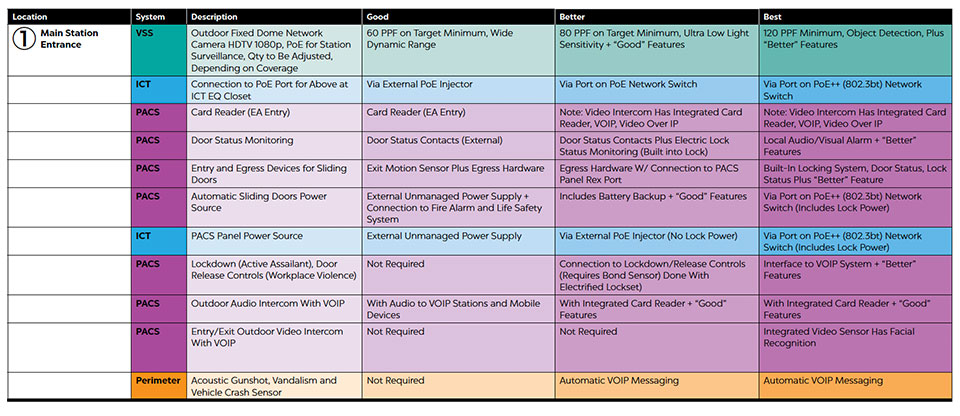
Good, Better and Best system recommendations for main station entrance, including specifications for video surveillance, ICT, PACS and perimeter systems. To view the guidance with all graphs and charts, please download the full PDF.
② Transit Vehicle Entry
Main gate for transportation vehicles (buses) to enter the complex from the street.
- Outdoor IP camera which has license plate capture and recognition of arriving vehicles
- Vehicle presence sensors

Good, Better and Best system recommendations for transit vehicle entry, including specifications for video surveillance, ICT and parking. To view the guidance with all graphs and charts, please download the full PDF.
③ Transit Vehicle Exit
Main gate for transportation vehicles (buses) to exit the complex to the street.
- Similar levels as ② TRANSIT VEHICLE ENTRY
- Outdoor camera has license plate capture and recognition of arriving vehicles (Best)

Good, Better and Best system recommendations for transit vehicle exit, including specifications for video surveillance, ICT and parking. To view the guidance with all graphs and charts, please download the full PDF.
④ Customer Parking
Short-term parking lot for customers.
- Intercom for two-way communication to provide access exceptions
- Assistance beacons (Best)
- Vehicle presence sensors, for ease in parking space location finding

Good, Better and Best system recommendations for customer parking, including specifications for video surveillance, ICT, PACS, communications, perimeter and parking. To view the guidance with all graphs and charts, please download the full PDF.
⑤ Bus Bay Parking
Bus parking area for buses that are accepting or discharging passengers or are temporarily out of service.
- Pedestrian access has egress hardware with built-in door status and request to exit contacts
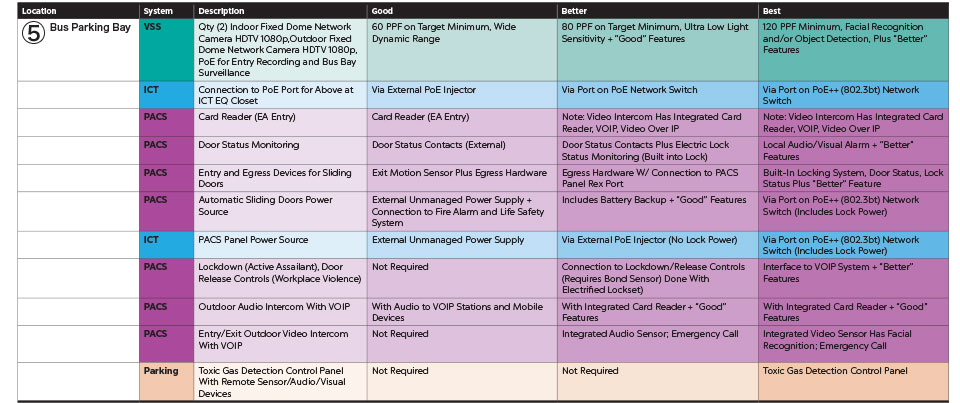
Good, Better and Best system recommendations for bus bay parking, including specifications for video surveillance, ICT, PACS and parking. To view the guidance with all graphs and charts, please download the full PDF.
⑥ Bus Stop Waiting Area
Passenger waiting area for buses.
- Similar levels as ① MAIN STATION ENTRY but with indoor cameras
- Single door has egress hardware with built-in door status and request to exit (REX) contacts (Best)
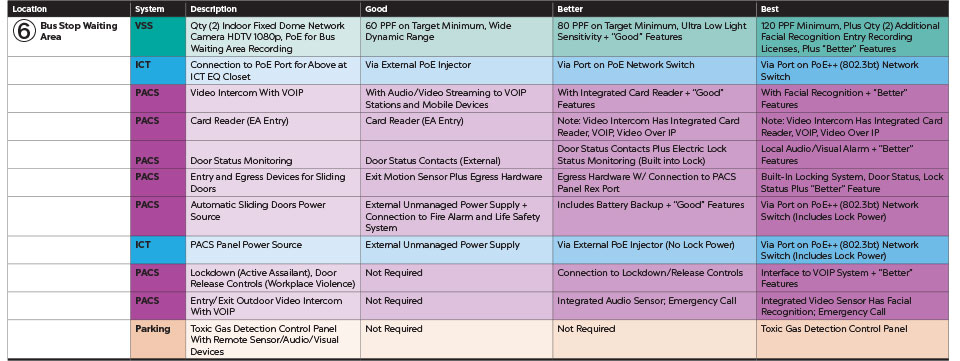
Good, Better and Best system recommendations for bus stop waiting area, including specifications for video surveillance, ICT, PACS and parking. To view the guidance with all graphs and charts, please download the full PDF.
⑦ Other Station Entry/Exit
Alternate station entry/exit, typically designed for lower throughput with a smaller number of turnstiles, and only automated fare vending.
- Single door has egress hardware with built-in door status and request to exit (REX) contacts (Best)

Good, Better and Best system recommendations for alternate station entry/exit, including specifications for video surveillance, PACS and ICT. To view the guidance with all graphs and charts, please download the full PDF.
⑧ Elevated Rail Tracks & Platform
Oudoor waiting area and exit area for rail passengers. May contain seating areas and outdoor shelters for inclement weather.
- Outdoor cameras’ quantity and placement is 60ppf (Good), 80ppf (Better), 120ppf (Best) allowing FR as BEST
- Audio and video intercoms always VoIP compatible, video intercom is video over IP compatible (desktop VoIP station) and mobile device compatible
- Assistance beacons (Best)
- All VSS camera and PACS panel power provided by network switches with PoE (Better); lock power provided by PoE++ (Best)

Good, Better and Best system recommendations for elevated rail tracks and platforms, including specifications for video surveillance, ICT, communications and perimeter. To view the guidance with all graphs and charts, please download the full PDF.
⑨ Underground Rail Tracks & Platform
Indoor waiting area and exit area for rail passengers. May contain seating areas.
- Same as ⑧ ELEVATED RAIL TRACKS & PLATFORM
- Outdoor cameras’ quantity and placement is 60ppf (Good), 80ppf (Better), 120ppf (Best) allowing FR as BEST Audio and video intercoms always VoIP compatible, video intercom is video over IP compatible (desktop VoIP station) and mobile device compatible
- Assistance beacons (Best)
- All VSS camera and PACS panel power provided by network switches with PoE (Better); Lock power provided by PoE++ (Best)

Good, Better and Best system recommendations for underground rail tracks and platforms, including specifications for video surveillance, ICT, communications and perimeter. To view the guidance with all graphs and charts, please download the full PDF.
⑩ Bike Share Location
Outdoor automated canopy for bike share customers to perform bike share transactions including pickup and drop-off.
- Outdoor cameras’ quantity and placement is 60ppf (Good), 80ppf (Better), 120ppf (Best) allowing FR as Best

Good, Better and Best system recommendations for bike share locations, including specifications for video surveillance and ICT. To view the guidance with all graphs and charts, please download the full PDF.
⑪ Data Center
Operations and storage for data and network devices required to operate the station.
- VSS cameras: 60ppf (Good), 80ppf (Better), 120ppf (Best) allowing FR as Best entry and exit
- Entry/exit card readers for electronic audit trail, synchronized with VSS cameras (All)
- Emergency egress hardware with both alert and REX connection at PACS panel (All)

Good, Better and Best system recommendations for a public transportation data center, including specifications for video surveillance, ICT and PACS. To view the guidance with all graphs and charts, please download the full PDF.
⑫ Public Safety Command Center
Operations office for monitoring of security and safety equipment and communication with emergency responders.
- Entry/exit card readers for access control and electronic audit trail, synchronized with VSS cameras (All)
- Audio and video intercoms always VoIP compatible, video intercom is video over IP compatible (desktop VoIP station) and mobile device compatible

Good, Better and Best system recommendations for a public safety command center, including specifications for video surveillance, ICT and PACS. To view the guidance with all graphs and charts, please download the full PDF.
More on G-B-B:
- Good-Better-Best: Comprehensive Best Practices for Implementing Public Transportation Security Systems (Vol. 2)
- Good-Better-Best: A Practical Guide to Implementing a Tiered Offerings Strategy for Customer Choice (for security systems integrators and distributors)
- Good-Better-Best: Comprehensive Best Practices for Implementing Security Systems in Health Care Environments
